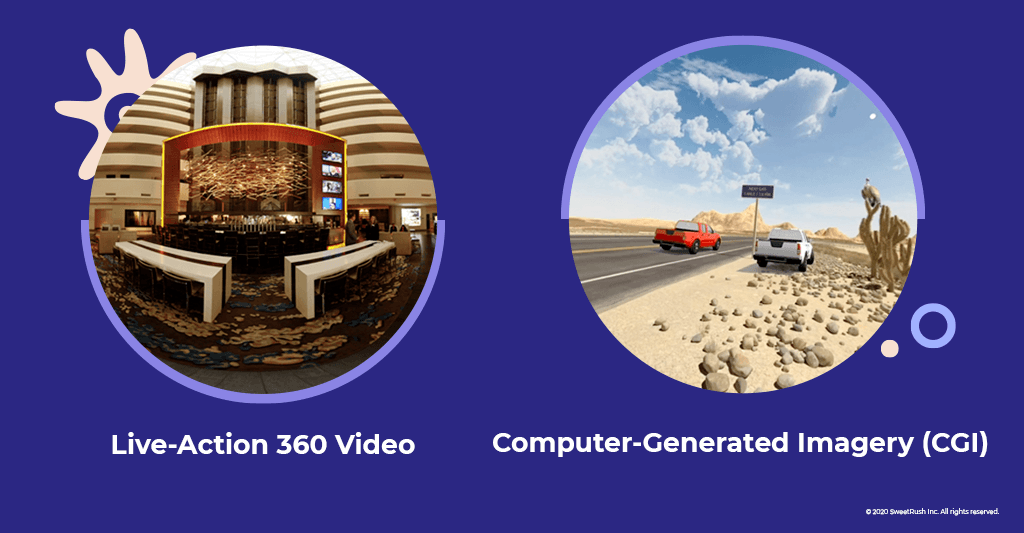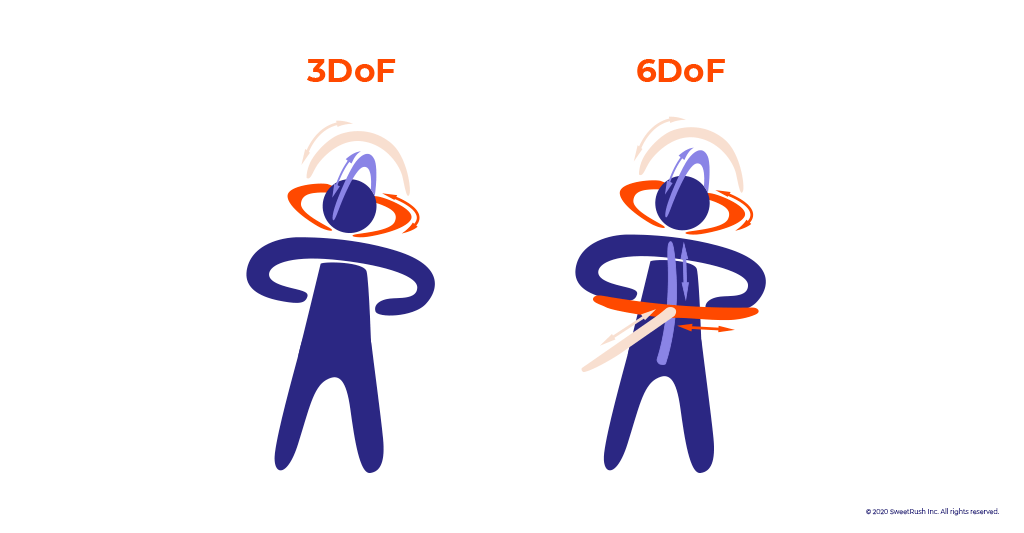Key Options That Affect VR Training Costs
There’s no need to sugarcoat the fact that Virtual Reality (VR) is an investment. Like simulations and game-based learning, VR training programs are typically at the higher end of complexity and interactivity—which means they take more effort to produce.

VR is still new—and changing—and there are many exciting possibilities for both producing VR and delivering VR. And the landscape changes as the technology evolves. Navigating these options to arrive at the best solution for engagement, efficacy, budget, and timeline is an art and a science, as the saying goes. These decisions are also at the heart of the cost and return on investment (ROI) equation for VR training.
In this article, we’ll look at some key options you’ll need to know about that affect cost. We’ll also highlight some important considerations for ROI. And, finally, we’ll share some best practices for gaining buy-in for the VR training investment.
2 Key Decisions That Affect The Cost Of VR: Headsets And Visual Approach
1. Which Headset Is The Right One For Your Needs?
Choosing a headset is one of the decisions that will have the biggest impact on your investment in VR training. The good news is that different options from different manufacturers are available at different price points. The key to making the best choice for you is understanding what you want to accomplish and lining that up with the features each headset provides.
One of the most important features that you’ll want to examine as you weigh headset options is the degrees of freedom (DoF). Let’s look at these options in more detail.
- 3DoF (3 Degrees of Freedom)
3DoF lets learners turn their heads in all directions: up, down, left, and right (rotational movement). Inside a virtual environment, they can look around, watch a video, ride a roller coaster, or be a virtual tourist in a foreign city. They can step inside and get a unique view that would be impossible to get in the physical world—for example, they can walk inside an engine. They can also interact with objects to some extent. 3DoF is a cost-effective option that can be a great way to meet your learning objectives. - 6DoF (6 Degrees of Freedom)
6DoF tracks both rotation and position, giving you the freedom not only to look in all directions, as with 3DoF, but also to move around the experience, which can increase the feeling of immersion and presence. Interaction with objects can be as sophisticated as the learning objectives require. With 6DoF, you can train a person how to move, how to position the arms, how to control the speed of movement, where to stand in a room, how to display nonaggressive body posture, etc. 6DoF is more expensive than 3DoF because of these additional features.
2. Which Visual Approach Will You Use?
The choice of visual approach will also affect project costs in your VR training strategy. A comparison of live-action 360 video and computer-generated imagery (CGI) reveals that each has its advantages. Let’s look at these two options in more detail.

Live-Action 360 Video As A VR Training Strategy
This approach uses footage and actors to create a VR experience. Special 360-degree camera rigs can capture all angles of whatever environment you need—an office space, a ship deck, a warehouse floor. With special software—and sometimes human assistance—images are “stitched” together so that when learners wear the headset, they can experience the environment and people just as they would in real life. User Interface elements (e.g., instructions) can be overlaid on the video footage to add to the experience.
Live-action 360 video can be cost-effective and the correct solution for certain projects, but there are variables that can increase expenses. Complex environments or movement can create technically challenging filming situations; more scenes mean more stitching and editing costs; and the more actors you use, the more your fees increase.
Interactivity and complexity can be limited in live-action 360 video. Learners cannot pick up and move objects in a video environment, for example.
CGI (Computer-Generated Imagery)
In the CGI approach, designers use 3D modeling to create a new digital environment and everything the learner sees in the environment. 3D designers create models, textures, and lighting so the environment and its objects can look as “real” as possible if that is desired. (If going for a realistic look, designers generally start with high-quality images of the real environment.) A more surreal or cartoon look is also possible. In either case, once the 3D environment is created, learners can interact with objects. For example, a phone will look like a phone, and learners can “pick up” the phone and use it during the activity.
You can create more complex interactions with CGI than you can with live-action 360 video. Instead of actors, CGI uses avatars (CGI people). Also, brand-new environments or settings can be imagined, created, and executed with CGI. Increasing the level of the detail of environments and avatars and adding more environments and objects will affect the cost, and CGI requires more powerful—and expensive—VR headsets. But the rewards can be highly entertaining: a learner can be represented as an avatar and interact with other learner-avatars in a multiplayer VR environment. Pretty exciting!
Understand And Evaluate The ROI Of A VR Training Strategy
As you shape your ROI picture, you’ll want to consider all of these aspects of cost and value for your VR training strategy:
- The essence of VR—full immersion—boosts retention and recall. VR accelerates performance improvement by offering a scalable, repeatable, and consistent practice modality that can be tracked and assessed, and it can help you reduce costly mistakes. When real-world situations are dangerous or hard to replicate, you can create a virtual environment in which your learners can safely practice skills.
- When you’re transforming a learning program that has high travel costs, a virtual blended learning program with a VR component may reduce overall costs, validating and—more often than not—making up for the up-front investment.
- You won’t use VR for every learning program; it will be part of your L&D portfolio. Use it where it will be most effective, just as you would use game-based learning, which also requires an up-front investment.
- Hardware costs are an up-front investment that can also be amortized over many learning programs. In the near future, a VR headset could be part of the standard equipment setup, especially for remote employees.
- The key options described above (live-action 360 video vs. CGI, DoF) are forks in the road that will affect cost. Your vendor-partner should help you navigate these options and arrive at the right solution that meets your needs.
- Work with your vendor-partner to evaluate the costs of deployment, including equipment and labor costs for distribution and maintenance.
- Data is valuable. Determine the data you will track both inside and outside the headset, and tie it to performance objectives and your ROI equation. (Your vendor-partner should have data tracking and reporting capabilities.)
- Don’t underestimate the value of VR in talent acquisition. VR technology speaks to younger generations and shows that you’re not just providing learning opportunities; you’re innovating, too.
5 Steps For Gaining Buy-In
We’ve followed several clients on their path to gaining leadership buy-in for VR training. Here are 5 best practices we’ve learned from organizations in multiple industries.
1. Introduce VR As An L&D Learning Opportunity
First, get educated on the big picture. Talk to a vendor that has a structured workshop on VR and can share the landscape of VR through an L&D lens.
2. Secure Budget For A Few Headsets For Key Team Members
VR is a “see it to believe it” technology. If you’re looking to pioneer VR at your organization, you need to get key decision-makers in a headset. This is a step that will go a long way toward gaining acceptance and buy-in.
3. Start With The Greatest Opportunity For ROI
Create a list of your most costly learning programs, the ones that are in need of redesign and/or transformation to virtual, and have the most impact on your business. This is where VR can likely give you the most bang for your buck. You may also look for opportunities to partner with sales and marketing to create VR experiences that can help you sell or get buy-in for a new product.
4. Connect With IT Early To Root Out Concerns For Your VR Training Strategy
This is a technology-enabled learning solution, so rest assured IT will want to evaluate what you’re doing. Uncover IT concerns early—this information will help you navigate the options. Rely on your vendor to engage in dialogue with your IT team.
5. Secure Budget For A Proof Of Concept
One option is to work with your vendor-partner to identify a small part of the overall learning program that would be a good fit for VR. Design proof of concept and organize a pilot. Share your findings and lessons learned with leadership, and then let them experience the magic of VR from that small pilot.
The Good News For L&D Teams That Opt For A VR Training Strategy
Across the industry, we’re seeing an increased demand for VR training. Many of the major technology players are leading the charge to invest in the development of VR headsets and technologies. And with this competition and commoditization, we anticipate prices will continue to drop.
It’s not out of the question that in the near future a VR headset could be included in the start-up technology package for new employees. Phones and laptops are already considered common business accessories, and VR headsets could soon follow suit.
Now is an opportune time to learn about and consider the full range of options available for VR training. When you discuss your unique learning challenges with your learning vendor-partner, you’ll better understand how to best leverage this cutting-edge technology and develop a custom solution for your L&D programs.
Ready to start your journey toward becoming a VR champion? For a lot more information, download Your Guide To VR Training Programs: Virtual Reality For Our New Reality. In this comprehensive guide, you’ll learn the key benefits and advantages of VR training to help you along your learning curve and provide you with further insights into how to influence the decision-makers at your organization. Join the webinar VR Training Program Case Study to learn all you need to know through a success story!











